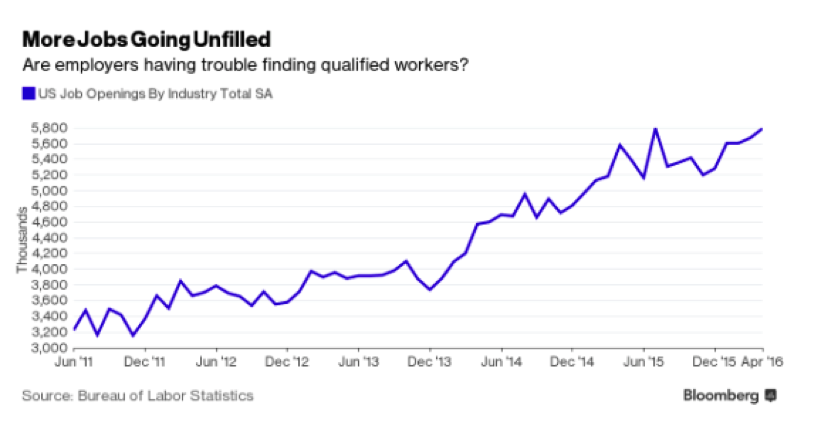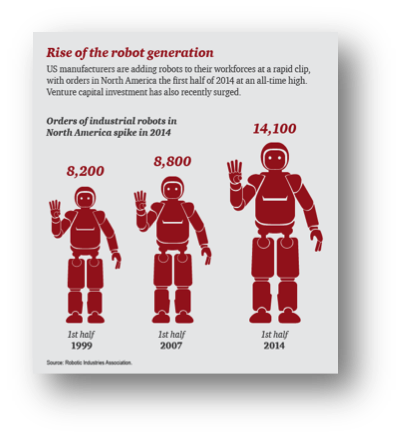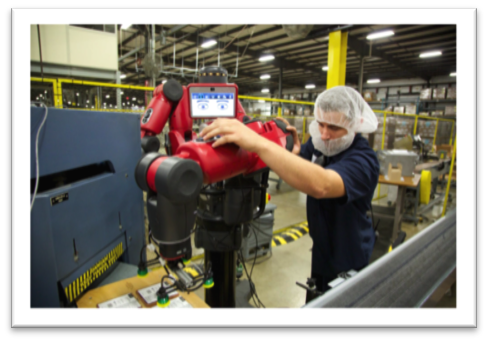6 reasons why the time is now for a Blue Ocean Strategy for Liberal Arts Colleges?
Several important facts surfaced at a recent Blue Ocean Strategy® workshop which we at SAMC led with Michigan industry leaders and independent colleges, hosted by the Michigan College Alliance. There were 6 big ones that were most unsettling:
- There is a HUGE problem in the U.S. — a MAJOR TALENT GAP.
- As US. News and World Report states: “Employers are looking to hire people with more advanced skills, especially in STEM fields, but job seekers are often struggling to figure out which skills they need and where they can learn them.”
- And 500,000 of those unfilled jobs are in IT.
- What’s more, we need these people now. All across America, we are running out of skilled workers to fill the 5.8 million jobs that are waiting for them. Take a look:

- Furthermore, the Gen Ys — the new hires going into these jobs — were expected to spend 4.4 years on the job, at least in 2012. But what employers are finding is that they in fact are staying only 2.5 years and then moving on before projects are even completed. Employers have no systems for these fast-moving workers and no processes to train and develop them, or even to provide the right management. And what about the poor recruiters who have to find 10,000 people’s worth of new talent for their global companies? Where do they look and what are they looking for?
 On top of all of that, the “robots are coming.” It is expected that by the year 2035, 53% of jobs now done by workers will be replaced by robots. This is good news and bad news, since it is expected that robots will take over low-skilled jobs,
On top of all of that, the “robots are coming.” It is expected that by the year 2035, 53% of jobs now done by workers will be replaced by robots. This is good news and bad news, since it is expected that robots will take over low-skilled jobs,
leaving much higher-skilled jobs to us humans. Indeed, there will be a lot of jobs keeping those robots going, much like what’s going on at Baxter Works at Praxis Packaging in Grand Rapids, MI.

Big Gap Between Independent Liberal Arts Colleges and The Needs of Business
What does this all mean for the students in independent liberal arts colleges?
To try to find answers, the Lumina Foundation conducted research in 2014 with the Economist Intelligence Unit. They interviewed 343 executives who were familiar with workforce-development and higher-education strategies.
The overwhelming consensus from the industry side was that:
“…too many graduates lack critical-thinking skills and the ability to communicate effectively, solve problems creatively, work collaboratively and adapt to changing priorities. In addition to these ‘soft skill’ deficits, employers are also finding that young people lack the technical, or ‘hard,’ skills associated with specific jobs.”
Didn’t sound as if colleges were doing as much as they should or could be doing. What is their role in preparing their graduates for successful careers in jobs that are waiting for them.
Better collaboration and coordination is needed, now!
One insight that emerged in our workshop was that business and higher education need to get massively better at collaborating and coordinating with each other. Given today’s highly demanding job market, colleges need to listen to business and adapt their academic offerings so that students are better equipped to master the 4C’s: Collaborate, Communicate, Create and Coordinate, along with specific skills needed by industry. Industry has to get better at helping those colleges innovate, without risking their accreditation and alienating their faculty and students.
Can higher education be transformed — and quickly?
In the U.S., higher education has for much of its history done an excellent job preparing students for society and the work force. But this has been true for a workplace that is no longer here today. Entry level jobs for repetitive tasks and middle management have been replaced by ones requiring computer and high tech skills, and these need to be coming from people with creative problem-solving minds who can collaborate, coordinate and think critically.
This has led to a major disconnect between colleges’ current curriculum and the skills their graduates need immediately upon leaving campus. However, college faculty remains rigidly protective of their traditional roles, such as teaching history or science, even when these roles are woefully out of step with today’s new industrial demands.
Sounding the alarm, Dane Linn, who oversees the Education and Workforce Committee at the Business Roundtable, an association of chief executive officers of leading U.S. companies, writes:
“The design of the curriculum has not changed for a long time and doesn’t reflect the types of jobs employees do in the workplace. Colleges and universities think they’re adequately preparing students for the workforce. You couldn’t have a more stark difference of opinion from industry. They’re not getting anywhere close to what they need.”
Indeed, when you examine the data, higher education in the U.S. has sent our young graduates to almost the bottom of the list globally. This is a huge change from the Baby Boomer years when U.S. higher education produced graduates on par with the rest of the world. Sadly, today’s graduates are bottom rung.
As the Lumina Foundation’s research shows:
“The latest educational attainment statistics underscore the extent of the problem. Recent analysis by The New York Times of data from the past 35 years shows that the educational attainment in the US ‘has risen far more slowly than in much of the industrialized world over the last three decades, making it harder for the American economy to maintain its share of highly skilled, well-paying jobs.’ While the literacy, numeracy and technology skills of older Americans stack up well in international comparisons, younger Americans rank near the bottom compared with other rich countries.”
What could a Blue Ocean Strategy do?
Blue Ocean Strategy is a proven, highly successful theory, method and tool kit that helps organizations open new market space (a “blue ocean”), avoiding the “red ocean” of competition altogether. Based on research outlined in Renée Mauborgne and W. Chan Kim’s book of the same name, Blue Ocean Strategy pushes companies to search for unmet needs among nonusers in order to grow their businesses in ways they had not been able to see beforehand.
When is someone in academia going to wake up and smell the textbooks? Better yet, come up with a strategy to better serve the needs of industry that at the moment is flooded with graduates ill-prepared for the world that needs them?
I will share with you in my next blog more of the Blue Ocean ideas that emerged from the workshop. Maybe they can help others build much-needed bridges between business and colleges, and quickly. Otherwise, today’s students are headed toward the painful realization that their college loans have not prepared them for life in the fast lane. Ouch.
From Observation to Innovation,

Andi
Corporate Anthropologist | President
Simon Associates Management Consultants



